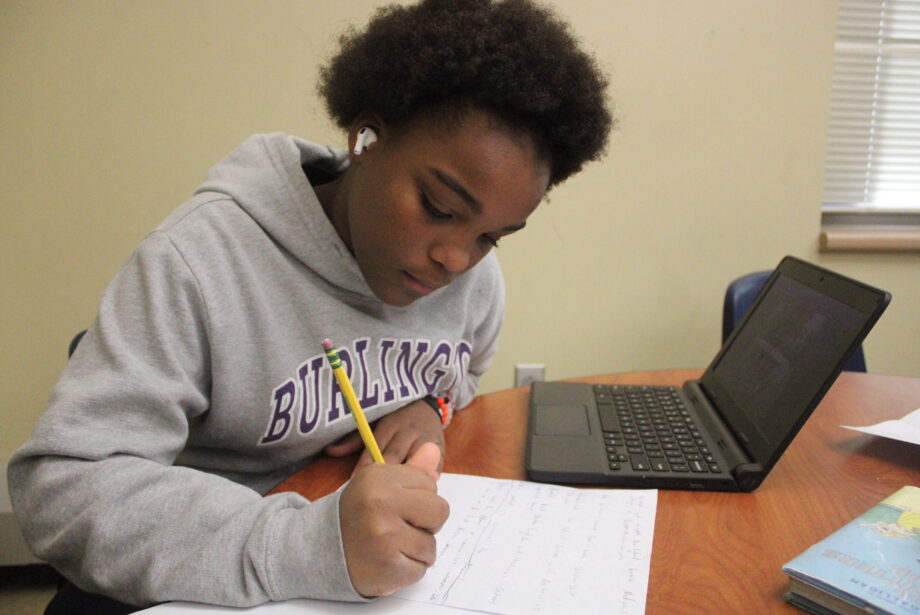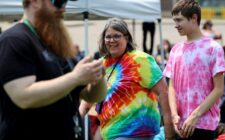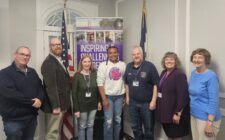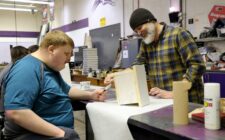On the afternoon of Feb. 22, 2023, Jennifer McLaughlin’s students took a step back from the display components they set out on a table inside the auditorium of Aldo Leopold Intermediate School to examine their combined aesthetic.
After rearranging the items a handful of times, the fifth grade scholars determined it was ready — but its completion did little to calm their nerves.
“We know that everyone’s going to see it and stuff,” Geordie Clark explained.
For the past four weeks, Aldo Leopold students and staff had been preparing for the school’s second annual Black History Museum that opened to the community Feb. 24 and saw more than 800 visitors, up significantly from last year’s event, which drew more than 500 visitors in a two-and-half hour window.
Not only were the hours extended, but there also were plenty of snacks, with area businesses providing nearly 2,000 brownies and cookies for visitors to enjoy as they took in more than 20 exhibits created by students and a handful of other displays and artwork on loan from the African American Museum of Iowa.
The museum also featured several live local exhibitors, including business owner Sarah Hall; Southeastern Community College head basketball coach Lorenzo Watkins; Burlington police officer Jesse Hill; Shaunda Campbell, a behavior interventionist at Great Prairie Area Education Agency; Antonio Redd, a student facilitator at Aldo; Cree Webb, a social worker at Aldo; Mack Turner, a former principal of Burlington High School who now works at SCC; the Rev. Orlando Dial; and former Burlington mayor and current Des Moines County supervisor Shane McCampbell.
“Those are people from our community who volunteer their time to come in and share with us their experiences as a living example of Black history in Burlington,” instructional coach Melissa Nelson-Chiprez said as she and members of her family worked to set up the museum. “One of the standards is urging the kids to connect it to Iowa specifically and then even more narrowed down to our communities specifically, so we really wanted to bring in community partnerships and liaisons and people who have unique experiences with their own Black history so to speak in our community, so we invite community members.”
Students interviewed each of the live exhibitors ahead of time and used the information gleaned during those interviews to create exhibits for them. Nelson-Chiprez said this portion of the school-wide project helped to build on listening and speaking skills.
Aldo first hosted the Black History Museum last year and quickly decided to make it an annual event.
Social studies teacher Amber Dains said the project helps to build interest and engagement in history among students.
“Social studies is about a bunch of dead people and numbers, so it’s super boring and the last thing you want to do when you’re in fifth or sixth grade is to learn about things that happened a long time ago, and so (this project is) trying to bring it to life and to give them ownership,” Dains said.
It also helps them to understand cause and effect in a cross-curricular fashion and familiarizes students with significant influencers in the days before social media.
“We just studied Martin Luther King Jr. and then talking about that and they studied in reading class Ann Frank, and that they were born around the same time,” she said.
In January, her students studied the civil rights movement before moving on to Mahatma Gandhi to examine his influence on Martin Luther King Jr.
She said one group of students was frustrated when they couldn’t find information about their assigned person on the internet.
“They were like, ‘we can’t find any information. Why can’t we find any information?’ So we were talking about how in the 1800s, there was no written literature. There was nothing documenting African Americans, and one of the kids goes, ‘Well that’s not fair. They’re people,’ ” Dain said. “Right. Were they treated like people back then? It bridges that gap of why are people so angry, why are there these mass, angry movements. It didn’t happen that long ago. Ruby Bridges is the same age as my mom, and when I tell the kids that, they’re like, ‘Oh my gosh. They could’ve gone to school together,’ and so they’re able to bring that to life with these kinds of projects, and hopefully they remember, maybe not the person, maybe not the talk, but the life lessons.”
Teaching staff developed units around research-based project learning, meaning the scholars do all the research themselves. They then organized that research into categories such as music, literature, art, and artifacts to determine what to incorporate into their exhibits, which they put together as a class.
The event requires cross-classroom collaboration, with teachers pitching in “artifacts” such as an old typewriter, boxing gloves, and other items as requested via a shared Google doc.
Nelson-Chiprez said the event “takes a village” to put on, but it’s worth it.
“(The museum’s) origination was just really wanting the kids to learn
how to research and relate it back to social studies standards, and then also relate it to creating equity and equality and systemic change in society and wanting to build awareness for our students about those things,” Nelson-Chiprez said. “Each class picks a separate person, and then they do the research and put together exhibits for our museum.”
For McLaughlin’s class, that person is Bessie Coleman, the first African American and Native American woman to hold a pilot’s license. She also was the first Black person to hold an international pilot’s license.
Another class chose to do their display on Claudette Colvin, who at the age of 15 was arrested for refusing to give up her seat to a white woman on a segregated bus, becoming a pioneer of the 1950s civil rights movement.
“She had to go to jail, so we kind of did it half-and-half,” Lydia Barnes said earlier this month while coloring a picture she and her classmates drew of Colvin. “Over here is she’s crying and there’s bars behind her because she had to go to jail, but then over here, it’s all happy and stuff because she was able to change just a little something in the world by fighting for what she believed.”
While Barnes’ group worked on the drawing, another group of students made a poster board using newspaper articles about Colvin.
“We’re working on making a poster board out of newspapers that show what she did and how famous she was at that time, and the significance of our project is just to show how famous she was and how big of a deal it was back then,” Rogan Francis said. “It shows the African American culture that happened back in the day, and it shows the underdog story instead of just Rosa Parks and the aftermath.”
While some social studies teachers allowed their students to select a person themselves, others assigned their classes to a historic figure.
Dains based her assignments on the subject taught by each class’s homeroom teacher. She assigned a math teacher’s homeroom class to Mary Mahoney, the first African American to study and work professionally as a trained nurse in the U.S. For a reading teacher’s homeroom class, she assigned Gwendolyn Brooks, the first African American to win a Pulitzer Prize. Dains’ homeroom was assigned Mildred Loving, who was one half of an interracial couple deemed illegal. Their case went to the Supreme Court.
“Giving them a project like this takes it to that next level of bringing history to life and that these people did something in their ordinary lives, and they need to be honored, and maybe I can do something in my ordinary life to be a person of influence,” Dains said.













